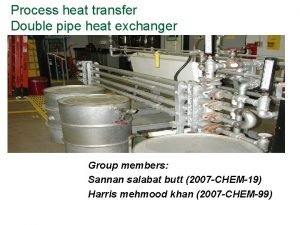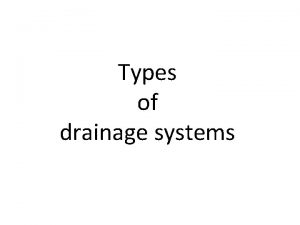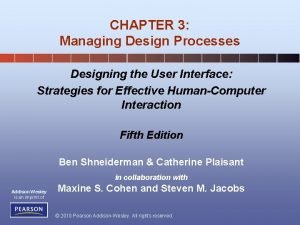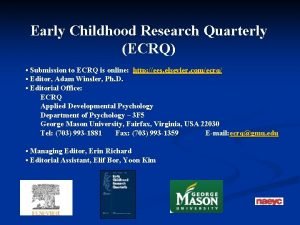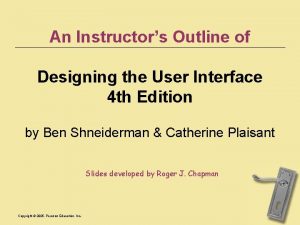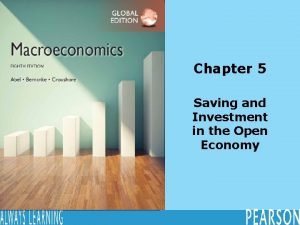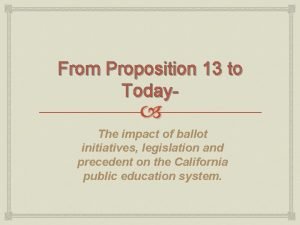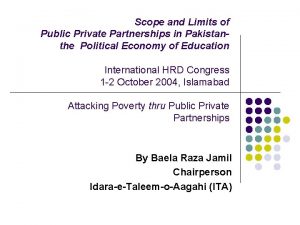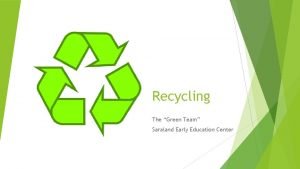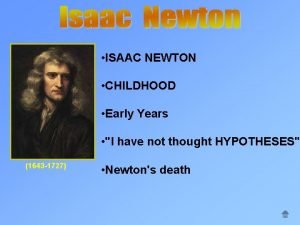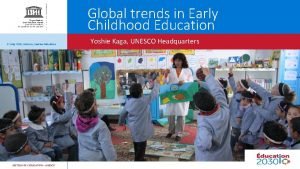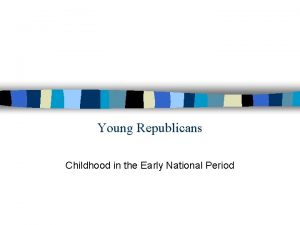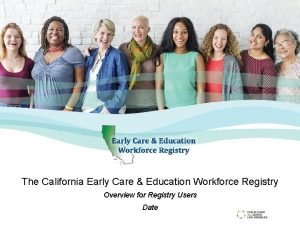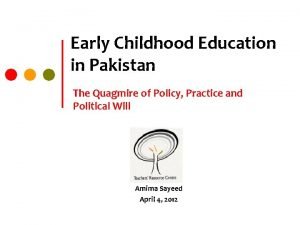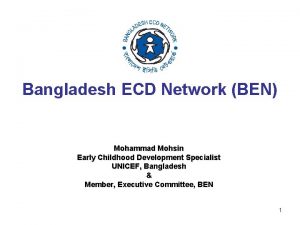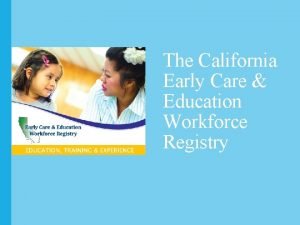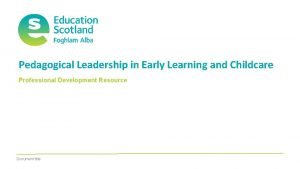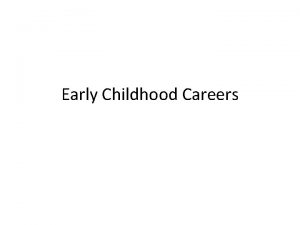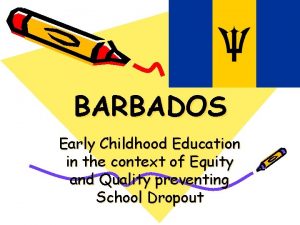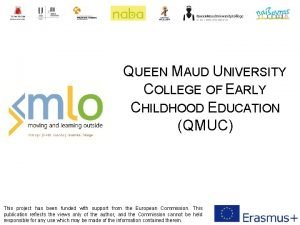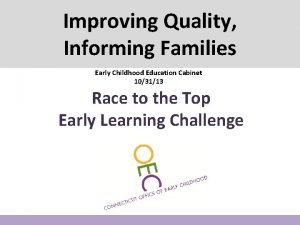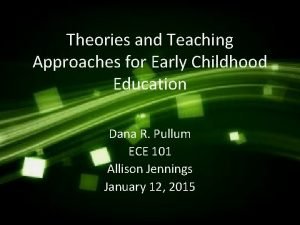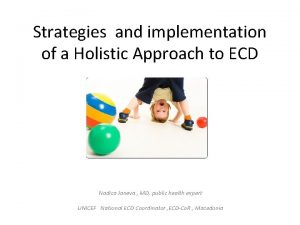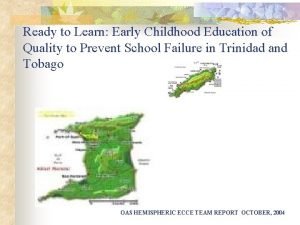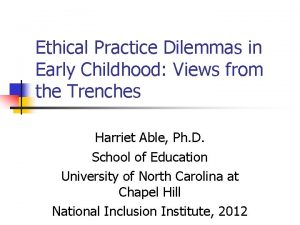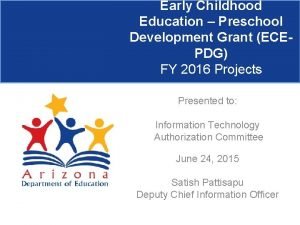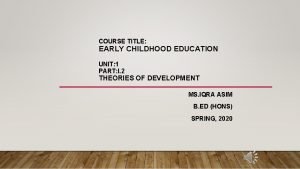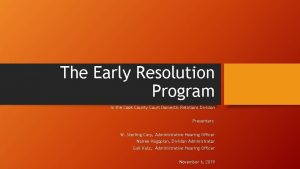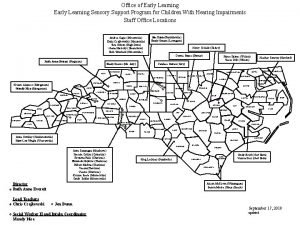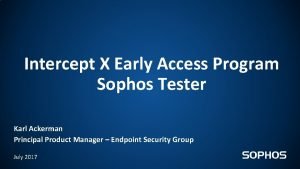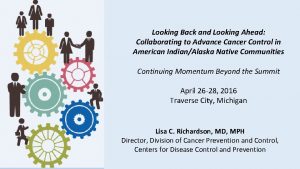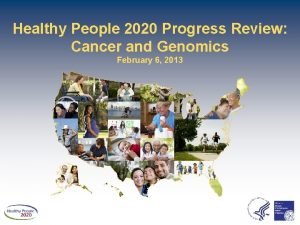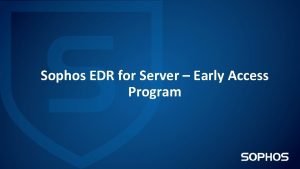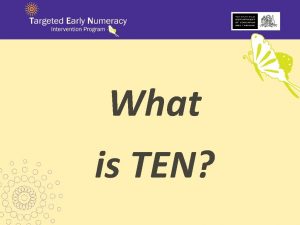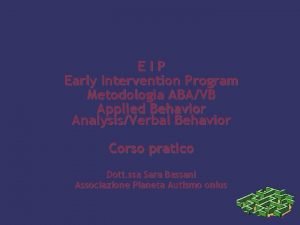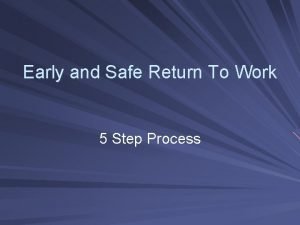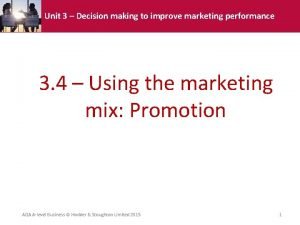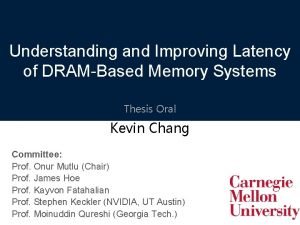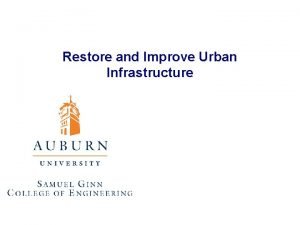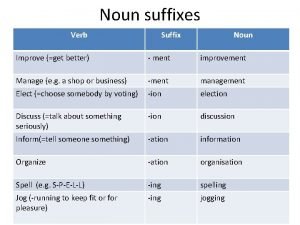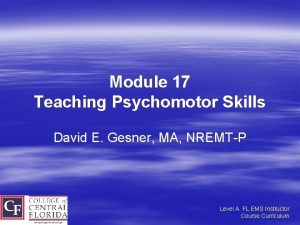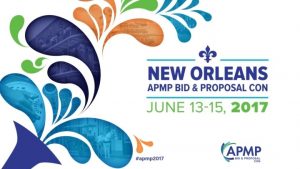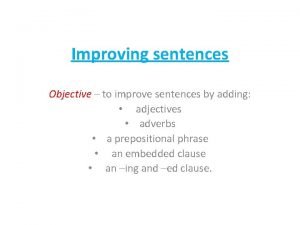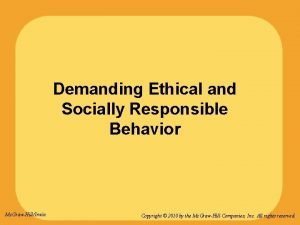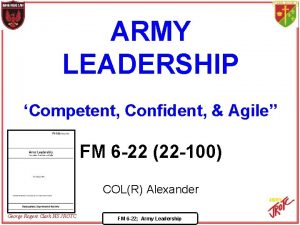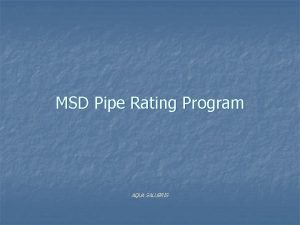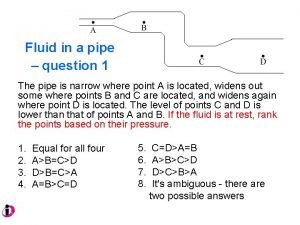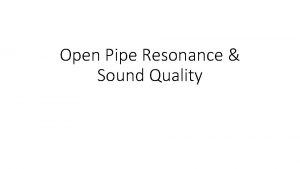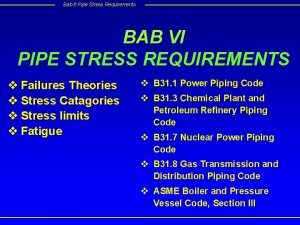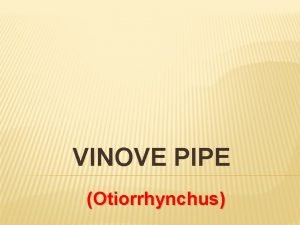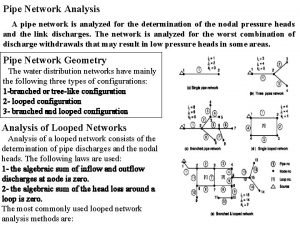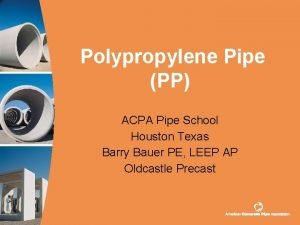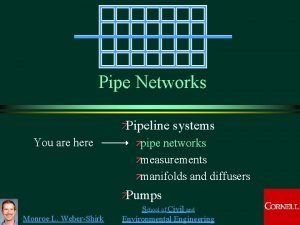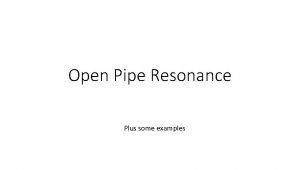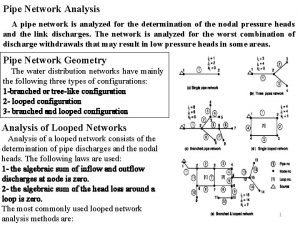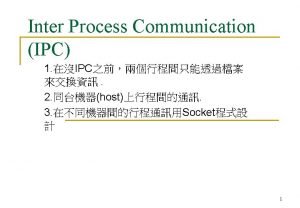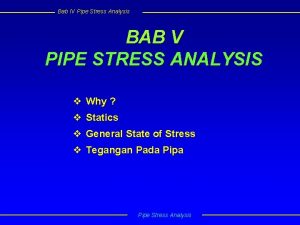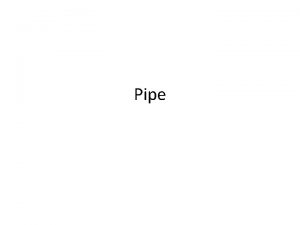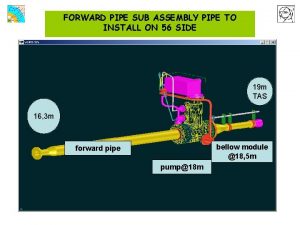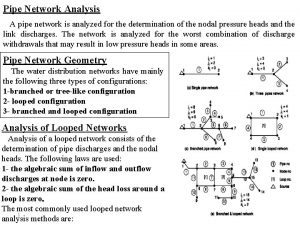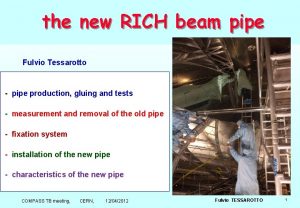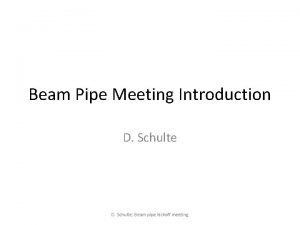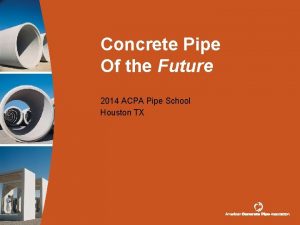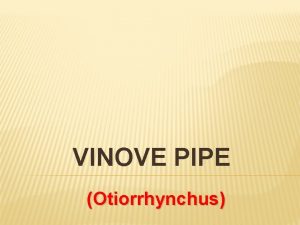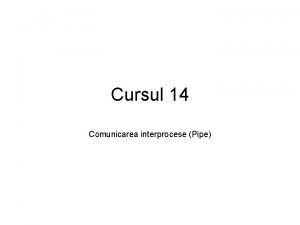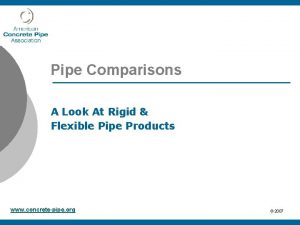Program to Improve Private Early Education PIPE IMPACT























































- Slides: 55

Program to Improve Private Early Education (PIPE) IMPACT ASSESSMENT 2018 (DIPSTICK) © FSG | 1

Glossary of terms (1 of 2) 1 year PIPE APSs: APSs with partner solutions for 1 year 2 year PIPE APSs: APSs with partner solutions for 2 years Activity-based learning (ABL): Learning through structured play-based activities, games, and experiences that provide developmental benefits across the cognitive, physical, and socio-emotional domains ABL solution provider: Private companies providing ABL solutions including curriculum materials, teacher training and continuous support for proper implementation of the program Administrator: Individual business-persons who leverage an existing asset or infrastructure to set up APSs. Administrators predominantly run these schools. Affordable Private School (APS): Educational institutions that are accessed by low-income households. APSs operate from Kindergarten to grade 8 or above, are not government-aided, trust-aided or trust-funded and charge all-inclusive fees between INR 500 – INR 1650 per child per month (i. e. , including books, tuition fee, admission/ readmission fee, uniforms, and excluding transportation) Control APSs: APSs using no external interventions Early Childhood Education (ECE): The formal education a child receives between the ages two through five. Although early childhood is typically considered to range from birth to age six, this narrower definition has been chosen to reflect the research’s interest in the years when formal pre-primary education is typically provided in India English-medium education: Education with English rather than the local vernacular as the primary language of instruction Full curriculum PIPE APSs: PIPE APSs using full school curriculum Learning Manager: Member of ABL solution provider’s implementation team assigned to facilitate implementation in a particular school. A Learning Manager assigned to a school will deliver all touchpoints to that school (including school visits, teacher training, parent engagement visits etc. ) Markers: Indicators or signs that parents use to assess whether their child is learning “Right” markers: Parents assess their children are learning by asking if they can actually understand the content “Wrong” markers: Parents assess if their children are learning by asking if they can recite rote memorized content © FSG | 2

Glossary of terms (2 of 2) Partner: 8 private companies providing high-quality ABL solutions to the APS market Partner solutions: Play/ activity based programs including curriculum materials and continuous support for proper implementation of the program, provided by PIPE partners PAT: Pre-school assessment tool to assess the impact and sustainability of ABL in APSs PIPE APSs: APSs using PIPE partner solutions Preschooling/Preprimary classes: All formal educational classes prior to first grade Program to Improve Private Early Education (PIPE): Program to replace rote memorization technique with activity based learning in the ~300, 000 APSs in India Single subject PIPE APSs: PIPE APSs usingle subject curriculum Socioeconomic class/NCCS: The New Consumer Classification System (NCCS) is used to classify households into socioeconomic classes based on two variables: Education level of the chief wage-earner, and the number of consumer durable goods owned by the household from a predefined list of 11 durables. For a full list of variables and the exact classification system, see http: //www. mruc. net/? q=new-consumer-classification-systemnccs Standalone preschool: Preschool providers that do not offer classes beyond preprimary Tuition class: After-school coaching/tutorial classes that provide extra academic support to children “Working poor” households/Low-income households: Households belonging to socioeconomic classes D 1 to A 3 under the New Consumer Classification System (NCCS). These households constitute the middle 70 percent of urban India and have an average monthly household income of between INR 9, 000 and INR 20, 000. The term “low-income household” has been used interchangeably with the term “working poor” © FSG | 3

Agenda 1 Objectives of the assessment 2 Research design and methodology 3 Key assessment findings 4 Introduction to PIPE and FSG 5 Appendix © FSG | 4

PIPE conducted assessments in APSs to assess the impact and sustainability of ABL Objectives of the assessment • Assess impact of partner solutions by comparing APSs with PIPE partner solutions, to APSs that have no external interventions • Assess sustainability of ABL in APSs delivered by a PIPE partner © FSG | 5

Agenda 1 Objectives of the assessment 2 Research design and methodology 3 Key assessment findings 4 Introduction to PIPE and FSG 5 Appendix © FSG | 6

PIPE developed a pre-school assessment tool and hired an external organization to conduct dipstick assessments in 58 APSs l PIPE developed the pre-school assessment tool (PAT)1 to assess the impact and sustainability of ABL in APSs – The tool assesses schools across 5 key sections namely classroom environment, student learning outcomes, parent interviews, teacher interviews and owner interviews l PIPE hired an external agency (Reniscience Education) and trained assessors to conduct the assessments l PIPE developed a sampling plan that included – 38 APSs with partner solutions and 20 APSs with no interventions – 26 APSs with partner solutions for 1 year and 12 APSs with partner solutions for 2 years l Reniscience Education conducted the assessments at 58 APSs l PIPE ensured data consistency and accuracy by independently conducting assessments in 2 APSs in each of the cities and comparing the data collected by external assessors and PIPE team l PIPE analyzed the data to identify key findings which have been listed in this document Assessment commissioned by 1 To refer to the pre-school assessment tool and the approach to developing the tool click here © FSG | 7

PAT contains 5 distinct steps to track impact and sustainability Sections Parent interviews Evaluating level of parent engagement Checking if parents assess learning l l Conducive home environment is essential to reinforce learning l What would you ask your child to check if they are learning Math? l Description l Rationale Examples 1 Teacher interviews Impact Owner interviews Checking if – TLMs are available – teachers are trained – teachers are capable l l Logistical readiness and teacher training are essential to implementation of ABL l How many training sessions have you attended? Classroom environment Checking if owners – value ABL – share benefits with parents – plan to continue using ABL l l Owner buy-in and understanding is essential for continued use of ABL l Are you planning to start /continue using ABL? 1 To refer to the pre-school assessment tool and the approach to developing the tool click here Student learning outcomes Assessing physical setup of classroom Assessing culture through peer interactions and teacher-student engagement l Measuring students’ learning outcomes in English, Math and motor skills l Interactions & risk taking involved in ABL can happen only in safe learning environments l ABL will improve students‘ understanding of concepts and learning outcomes l Teachers asks open ended questions and responds positively to students l Can you read “PIN”? l © FSG | 8

The findings in this document are based on assessment of 58 APSs across 5 cities l 38 APSs with partner solutions l 20 APSs with no interventions l Delhi, Mumbai, Hyderabad, Chennai and Bangalore Assessed 290 children l 190 students from APSs with partner solutions l 100 students from APSs with no interventions Interviewed 232 parents l 152 parents from APSs with partner solutions l 80 parents from APSs with no interventions Interviewed 116 teachers and owners l 58 owners (1 per APS) l 58 teachers (1 per APS) Assessed 58 APSs across 5 cities © FSG | 9

Agenda 1 Objectives of the assessment 2 Research design and methodology 3 Key assessment findings 4 Introduction to PIPE and FSG 5 Appendix © FSG | 10

PIPE APSs have scored better than control APSs on dipstick assessment of 38 PIPE and 20 control APSs 1 l PIPE APSs scored 54% higher than control APSs, as ABL helps improve quality of education 2 l PIPE APSs scored higher than control APSs across all sections, showcasing a marked improvement in classroom quality and stakeholder awareness of learning 3 l PIPE APSs scored 80% higher than control APSs on classrooms being more interactive and conducive to student learning 4 l Thrice as many teachers in PIPE APSs use materials (e. g. , flashcards) correctly to teach concepts, as compared to control APSs 5 l APSs with PIPE partner solutions for 2 years as compared to 1 year, scored 40% higher on teachers’ engaging individually with children resulting in improved staff child interactions 6 l APSs with PIPE partner solutions for 2 years as compared to 1 year, scored 105% higher on teachers’ setting classroom norms or using routines resulting in increased student engagement during classes 7 l In PIPE APSs, ~2. 3 x students can read new English words and ~1. 3 x students can name more than 6 animals as compared to control APSs 8 l Children in PIPE APSs did not perform better than children in control APSs on Math learning outcomes 9 l Twice as many parents in PIPE APSs identified one question to check for learning in English, as solution providers have made parents more aware about it © FSG | 11

PIPE APSs scored 54% higher than control APSs, as ABL helps improve quality of education Control APSs Average score: 29 PIPE APSs Average score: 45 54% Control APSs PIPE APSs % of schools 1 Total score (Out of 100) © FSG | 12

2 PIPE APSs have scored higher than control APSs across all sections, showcasing a marked improvement in classroom quality and stakeholder awareness of learning Total score (Out of 100)1 Section-wise scores 44, 9 29, 2 4, 6 9, 0 5, 9 5, 7 4, 0 Control APSs 8, 3 Classroom environment 10, 9 Student learning outcomes 8, 6 Parent interviews 9, 3 Teacher interviews Owner interviews 7, 8 PIPE APSs 1 Overall total score for PAT is 100. Total score for classroom environment is 30. Total score for student learning environment is 25. Total score for parent interviews is 20. Total score for teacher interviews is 13. Total score for owner interviews is 12. © FSG | 13

3 PIPE APSs scored 80% higher than control APSs on classrooms being more interactive and conducive to student learning Average score (Out of 30)1 Classroom environment scores Control APSs l PIPE APSs scored better than control APSs on – Staff-child interaction – Appropriate use of materials (e. g. , flashcards) – Student engagement in class – Room arrangement to conduct activities l PIPE and control APSs have scored poorly on – Peer interaction (amongst children) – Opportunity for students to express themselves in class PIPE APSs 1 Total score for classroom environment is 30. 10 parameters (e. g. , room arrangement, displays etc. ) have been rated on a scale of 0 -3, each. © FSG | 14

Thrice as many teachers in PIPE APSs use materials (e. g. , flashcards) correctly to teach concepts, as compared to control APSs Teachers using at least 1 material in classrooms % of teachers 4 Control APSs l Compared to control APSs, most teachers in PIPE APSs conduct activities using materials with the entire class l Across APSs, observed very few instances of students using material in small groups or individually PIPE APSs © FSG | 15

Staff-child interaction scores Average score (Out of 3) 5 APS with PIPE partner solutions for 2 years as compared to 1 year, scored 40% higher on teachers’ engaging individually with children resulting in improved staff child interactions APSs with PIPE partner solutions for 1 year solutions for 2 years Scores 0 Staff are unresponsive or respond negatively to children 1 Staff interacts positively with the whole group and no negative physical contact 2 Items in 1 + Staff interacts positively with some individual children 3 Items in 2 + Staff are respectful to children and guide them positively © FSG | 16

Classroom norms and routines scores Average score (Out of 3) 6 APSs with PIPE partner solutions for 2 years as compared to 1 year, scored 105% higher on teachers’ setting classroom norms or using routines resulting in increased student engagement during classes APSs with PIPE partner solutions for 1 year solutions for 2 years Scores 0 Class is poorly managed with no norms, routines or expectations made visible or used and severe forms of discipline is used 1 Teachers use appropriate rules to manage class, and, staff do not hurt or intimidate children 2 Items in 1 + Children appear to be aware of class rules and expectations and teachers reinforce expectations gently 3 Items in 2 + Staff tries to involve children in solving their conflicts and problems © FSG | 17

7 In PIPE APSs, ~2. 3 x students can read new English words and ~1. 3 x students can name more than 6 animals as compared to control APSs Students able to name >6 animals Average # of students answered correctly (Out of 5) Students able to read ‘PIN’ 1 Control APSs PIPE APSs Control APSs 1 PIN is generally not taught as part of the regular curriculum and hence checks for ability to read new words PIPE APSs © FSG | 18

Children in PIPE APSs did not perform better than children in control APSs on Math learning outcomes Students able to count 12 sticks out of 20 Students able to identify largest number from a group of 6 single digit numbers Average # of students answered correctly (Out of 5) 8 Control APSs PIPE APSs © FSG | 19

Parents identified question to check children’s English skills Typical correct responses “My child has started speaking to the neighbors in English” % of parents 9 Twice as many parents in PIPE APSs identified one question to check for learning in English, as solution providers have made parents more aware about it “My child is learning the sound of English alphabets and not just memorizing the letters” “My child has started using phonics to read new English words” Control APSs PIPE APSs © FSG | 20

Agenda 1 Objectives of the assessment 2 Research design and methodology 3 Key assessment findings 4 Introduction to PIPE and FSG 5 Appendix © FSG | 21

The Problem: Children in school in India are not learning Weak foundation in early years 1 Leads to poor learning outcomes in secondary school 2 In grade 10 l 78% can’t read simple threeletter words l Only 35% students can read at grade 4 level l 54% can’t pick 12 pencils from a stack of 20 l Only 32% students can place decimal numbers in increasing order l 82% can’t complete a simple 4 -piece puzzle l Only 24% can calculate area of a circle Children are exposed to rote memorization techniques in early years and hence struggle to cope with primary education 1. Findings from assessment of 207 children commencing grade 1 in Affordable Private Schools (APSs), conducted by FSG in 2016 -17 2. Findings from assessment of 50, 000 students in grades 9 and 10, conducted by Education Initiatives in the states of Gujarat, Maharashtra and Rajasthan in 2013 -14 © FSG | 22

86% of children from urban, low-income families are exposed to pedagogically inappropriate “rote” techniques 1 2 Low-income families constitute ~70% of urban India 1 Low-income families aspire and are willing to pay for “quality education” for their children 3 4 86% of children from low-income households in urban India attend affordable private schools (APSs)2 APSs use pedagogically inappropriate “rote” teaching techniques 3 1. IRS 2014, The research selected households belonging to socioeconomic classes A 3 -D 1 according to the New Consumer Classification I 2 - FSG research. Percentage of parents of 4 and 5 year olds enrolled in a private educational institution. Assumes that those in non-APS private preprimary classes will transition on to grade one at an APS I 3 -1 - e. g. , the teacher would stand in front of the class and ask children to memorize “A for Apple, B for Bat, C for Cat. . . ” © FSG | 23

The Solution: Adopting activity based learning in early years can provide the right educational foundation to succeed in life Why focus on the early years? Nobel laureate James Heckman highlighted that return on investments in early years are highest compared to remedial programs later 1 Why focus on activity based learning? Activity based learning is the right pedagogy 2 in teaching children in the early years and giving them a solid foundation 1. J. Heckman and D. Masterov, The Productivity Argument for Investing in Young Children, Working Paper 5, Invest in Kids Working Group, Committee for Economic Development. 2004 I 2 - M. Hohmann, D. P. Weikart, ‘Educating Young Children: Active Learning Practices for Preschool and Child Care Programs’, Early Childhood Counts: Programming Resources for Early Childhood Care and Development. The Consultative Group on ECCD. World Bank. 1999 © FSG | 24

PIPE aims to replace rote memorization technique with activity based learning in 300, 000 APSs in India Click on image. Opens on You. Tube. Requires internet. Leading to children from low-income families getting a solid foundation and an equal opportunity to succeed in life © FSG | 25

PIPEs impact: More schools and better outcomes Control PIPE average 391 Number of APSs % of schools assessed 54% Jul 2015 Jul 2016 Jul 2017 Expected Jul 2018 Signed up Schools served by PIPE partners Preschool assessment test score Control (20 schools) PIPE (38 schools) 2018 Dipstick Assessment FSGs Pre-School Assessment Tool was used to asses 38 PIPE schools and 20 non PIPE control schools i. e. APSs where no ABL solutions have been introduced across classroom environment, student learning outcomes and engagement of teachers, owners and parents © FSG | 26

Our efforts are supported by To learn more about our work please visit www. fsg. org/pipe © FSG | 27

Our team* brings together strategic, educational, and operational experience and expertise Vikram Jain Program Lead l l Leads the PIPE program 15 years of strategy, operations and consulting experience Worked with Monitor Inclusive Markets, Mc. Kinsey and Deloitte MBA, London Business School Sriramprasad Rangarajan Partner Team l l Gauri Kirtane Quality Team l l l Over 10 years of experience in education leadership, with a focus on teaching, learning and curriculum design Most recently, Education Manager for more than 35 centers and 1200 students at the Akanksha Foundation Ed. D, University of Pennsylvania Lakshmi Narayanan G Field Team, Bangalore l l 7 years of work experience, with extensive experience in the education space in Bangalore MA-Development, Azim Premji University * The team shown here is representative of the PIPE team for 2018 -19 6 years of operations and consulting experience in India and Africa Launched an employability assessment tool that has been commissioned on 30, 000 +candidates Worked with HCL, Pw. C and Athena MSc Operations Research, LSE Sana Kazi Program Team l l l 6 years of consulting experience in the education sector Worked with Pw. C, Center for Civil Society and Goldman Sachs MPA, LSE Total team size: 14 Roles and responsibilities: l Partner team: Capacity building of partners, Best practice development l Quality team: Monitoring in schools , Best practice development l Program team: Dissemination and program management l Field team: Monitoring in schools © FSG | 28

FSG is a mission driven non-profit (501 c 3) focused on Scale Social Impact Catalytic Philanthropy that considers the big picture We are well known for having pioneered innovative approaches Inclusive Markets Creating markets that work for everyone Shared Value Creating business value and social value Collective Impact Organizing around common goals We use these approaches to help global leaders create impact and promote their effective use We leverage these approaches to run initiatives that create scale sustainable impact Early Childhood Education Low-income housing 100, 000 Opportunities Initiative © FSG | 29

FSG Inclusive Markets (FSG IM) believes that markets can and should benefit the poor We believe that markets should be part of the portfolio of solutions for social change. Our strength is in understanding how to make inclusive business models work, and how to get them to scale. We create impact in various program areas by: l driving new thinking for the field, and l making change happen on the ground. We are a “mission driven” and non-profit unit whose work is entirely public domain. © FSG | 30

Agenda 1 Objectives of the assessment 2 Research design and methodology 3 Key assessment findings 4 Introduction to PIPE and FSG 5 Appendix © FSG | 31

Classroom environment: PIPE vs Control APSs (1/2) PIPE Average score Control Average of Room Arrangement Note: Scores on a scale of 0 -3 Average of Displays Average of Expand Vocabulary Average of Encourage use of language Average of Materials and activities © FSG | 32

Classroom environment: PIPE vs Control APSs (2/2) PIPE Average score Control Average of Staffchild interactions Note: Scores on a scale of 0 -3 Average of Peer interactions Average of Discipline Average of Student engagement Average of Transition © FSG | 33

Student learning outcomes: PIPE vs Control APSs PIPE Average # of students answered correctly (Out of 5) Control Average of Students read PIN Note: Scores on a scale of 0 -5 Average of Students identified Students wrote their largest number from counted 12 sticks names a group of 6 numbers Average of Students named 6+ animals © FSG | 34

Student learning outcomes : PIPE vs Control APSs PIPE % of students answered correctly Control % of Students read PIN % of Students identified largest counted 12 sticks number from a group of 6 numbers % of Students wrote their names % of Students named 6+ animals © FSG | 35

Parent interviews: PIPE vs Control APSs PIPE Average # of parents answered correctly (Out of 4) Control Average of Parents valued English Parents identified Math conceptual learning Math marker learning Note: Scores on a scale of 0 -4 Average of Parents identified English marker Average of Parents value partner © FSG | 36

Parent interviews: PIPE vs Control APSs PIPE % of parents answered correctly Control % of Parents valued Math English conceptual learning % of Parents identified Math marker % of Parents identified English marker % of Parents value partner © FSG | 37

Teacher interviews: PIPE vs Control APSs PIPE Average score Control Average of Teacher to identify Math marker Average of Teacher to identify English marker Average of Teacher to No. of training No. of demo/ Teacher to describe an sessions monitoring share a activity for attended by sessions weekly plan senior teacher completed (Scale 0 -1) kindergarten by partner Note: Scores on a scale of 0 -2, unless specified otherwise Average of Teacher to observe benefits of ABL © FSG | 38

Owner interviews: PIPE vs Control APSs PIPE Average score Control Average of Owner to describe benefits of ABL Average of Owner to identify Math marker Average of Owner to identify English marker Note: Scores on a scale of 0 -2, unless specified otherwise Average of Owner shared Owner benefits of ensuring planning to ABL with teachers continue parents implementing using ABL (Scale 0 -1) Average of Owner to introduce ABLto other grades (Scale 0 -1) © FSG | 39

Total score Average score: Full curriculum vs Single subject PIPE APSs 47. 8 42. 0 Classroom environment Student learning outcomes Parent interviews Teacher interviews Owner interviews Full curriculum Single subject 1 Overall total score for PAT is 100. Total score for classroom environment is 30. Total score for student learning environment is 25. Total score for parent interviews is 20. Total score for teacher interviews is 13. Total score for owner interviews is 12. © FSG | 40

Classroom environment: Full curriculum vs Single subject PIPE APSs (1/2) Single Average score Full Average of Room Arrangement Note: Scores on a scale of 0 -3 Average of Displays Average of Expand Vocabulary Average of Encourage use of language Average of Materials and activities © FSG | 41

Classroom environment: Full curriculum vs Single subject PIPE APSs (2/2) Single Average score Full Average of Staffchild interactions Note: Scores on a scale of 0 -3 Average of Peer interactions Average of Discipline Average of Student engagement Average of Transition © FSG | 42

Student learning outcomes: Full curriculum vs Single subject PIPE APSs Single Average # of students answered correctly (Out of 5) Full Average of Students read PIN Note: Scores on a scale of 0 -5 Average of Students identified Students wrote their largest number from counted 12 sticks names a group of 6 numbers Average of Students named 6+ animals © FSG | 43

Parent interviews: Full curriculum vs Single subject PIPE APSs Single Average # of parents answered correctly (Out of 4) Full Average of Parents valued English Parents identified Math conceptual learning Math marker learning Note: Scores on a scale of 0 -4 Average of Parents identified English marker Average of Parents value partner © FSG | 44

Teacher interviews: Full curriculum vs Single subject PIPE APSs Single Average score Full Average of Teacher to identify Math marker Average of Teacher to identify English marker Average of Teacher to No. of training No. of demo/ Teacher to describe an sessions monitoring share a activity for attended by sessions weekly plan senior teacher completed (Scale 0 -1) kindergarten by partner Note: Scores on a scale of 0 -2, unless specified otherwise Average of Teacher to observe benefits of ABL © FSG | 45

Owner interviews: Full curriculum vs Single subject PIPE APSs Single Average score Full Average of Owner to describe benefits of ABL Average of Owner to identify Math marker Average of Owner to identify English marker Note: Scores on a scale of 0 -2, unless specified otherwise Average of Owner shared Owner benefits of ensuring planning to ABL with teachers continue parents implementing using ABL (Scale 0 -1) Average of Owner to introduce ABLto other grades (Scale 0 -1) © FSG | 46

Total score Average score: 1 year vs 2 year PIPE APSs 44. 3 46. 3 Classroom environment Student learning outcomes Parent interviews Teacher interviews Owner interviews 1 year 2 year 1 Overall total score for PAT is 100. Total score for classroom environment is 30. Total score for student learning environment is 25. Total score for parent interviews is 20. Total score for teacher interviews is 13. Total score for owner interviews is 12. © FSG | 47

Classroom environment: 1 year vs 2 year PIPE APSs (1/2) 2 year Average score 1 year Average of Room Arrangement Note: Scores on a scale of 0 -3 Average of Displays Average of Expand Vocabulary Average of Encourage use of language Average of Materials and activities © FSG | 48

Classroom environment: 1 year vs 2 year PIPE APSs (2/2) 2 year Average score 1 year Average of Staffchild interactions Note: Scores on a scale of 0 -3 Average of Peer interactions Average of Discipline Average of Student engagement Average of Transition © FSG | 49

Student learning outcomes: 1 year vs 2 year PIPE APSs 2 year Average # of students answered correctly (Out of 5) 1 year Average of Students read PIN Note: Scores on a scale of 0 -5 Average of Students identified Students wrote their largest number from counted 12 sticks names a group of 6 numbers Average of Students named 6+ animals © FSG | 50

Parent interviews: 1 year vs 2 year PIPE APSs 2 year Average # of parents answered correctly (Out of 4) 1 year Average of Parents valued English Parents identified Math conceptual learning Math marker learning Note: Scores on a scale of 0 -4 Average of Parents identified English marker Average of Parents value partner © FSG | 51

Teacher interviews: 1 year vs 2 year PIPE APSs 2 year Average score 1 year Average of Teacher to identify Math marker Average of Teacher to identify English marker Average of Teacher to No. of training No. of demo/ Teacher to describe an sessions monitoring share a activity for attended by sessions weekly plan senior teacher completed (Scale 0 -1) kindergarten by partner Note: Scores on a scale of 0 -2, unless specified otherwise Average of Teacher to observe benefits of ABL © FSG | 52

Owner interviews: 1 year vs 2 year PIPE APSs 2 year Average score 1 year Average of Owner to describe benefits of ABL Average of Owner to identify Math marker Average of Owner to identify English marker Note: Scores on a scale of 0 -2, unless specified otherwise Average of Owner shared Owner benefits of ensuring planning to ABL with teachers continue parents implementing using ABL (Scale 0 -1) Average of Owner to introduce ABLto other grades (Scale 0 -1) © FSG | 53

Average score: By city PIPE APSs Bengaluru Control APSs Bengaluru 43 Chennai 53 Hyderabad 49 Delhi Chennai 26 Hyderabad 41 Mumbai 30 34 Mumbai 25 51 Owner interviews Teacher interviews Parent interviews Student learning outcomes Classroom environment 1 Overall total score for PAT is 100. Total score for classroom environment is 30. Total score for student learning environment is 25. Total score for parent interviews is 20. Total score for teacher interviews is 13. Total score for owner interviews is 12. © FSG | 54

© FSG | 55
 Cocurrent flow heat exchanger
Cocurrent flow heat exchanger Partially vented single stack system
Partially vented single stack system Ecetp trainings
Ecetp trainings Social impact statement for early design review
Social impact statement for early design review Ecrq
Ecrq Social impact statement for early design review
Social impact statement for early design review Early cpr and early defibrillation can: *
Early cpr and early defibrillation can: * Impact of ict in education
Impact of ict in education Globalization impact on education
Globalization impact on education Serrano v priest impact on education
Serrano v priest impact on education Scope of public-private partnership in education
Scope of public-private partnership in education Saraland early education center
Saraland early education center Early childhood directorate
Early childhood directorate Isaac newton early life and education
Isaac newton early life and education Trends in early childhood education
Trends in early childhood education Early national period education
Early national period education Early education workforce registry
Early education workforce registry Early childhood education in pakistan
Early childhood education in pakistan Bangladesh ecd network
Bangladesh ecd network Early care and education workforce registry
Early care and education workforce registry Pedagogical leadership in early childhood education
Pedagogical leadership in early childhood education Associates in early childhood education jobs
Associates in early childhood education jobs Early childhood education barbados
Early childhood education barbados Queen maud university college
Queen maud university college Connecticut early childhood education cabinet
Connecticut early childhood education cabinet Bf skinner theory
Bf skinner theory Holistic approach in early childhood education
Holistic approach in early childhood education Swot analysis early childhood education
Swot analysis early childhood education Ethical dilemmas in early childhood education
Ethical dilemmas in early childhood education Early childhood education
Early childhood education Bf skinner early childhood education
Bf skinner early childhood education Early resolution program
Early resolution program Early learning sensory support program
Early learning sensory support program Sophos tester tool
Sophos tester tool National breast and cervical cancer early detection program
National breast and cervical cancer early detection program National breast and cervical cancer early detection program
National breast and cervical cancer early detection program Sophos
Sophos Targeted early numeracy intervention program
Targeted early numeracy intervention program Eip early intervention program
Eip early intervention program Early and safe return to work program
Early and safe return to work program Decision making to improve marketing performance
Decision making to improve marketing performance Improve memory latency
Improve memory latency Intrapersonal skills example
Intrapersonal skills example Restore and improve urban infrastructure
Restore and improve urban infrastructure Current ratio high or low better
Current ratio high or low better Verbs
Verbs Suffix
Suffix How to improve psychomotor skills
How to improve psychomotor skills If you cant measure it you can't manage it quote
If you cant measure it you can't manage it quote Kiss method keep, improve start stop
Kiss method keep, improve start stop Improving software economics geeksforgeeks
Improving software economics geeksforgeeks Ferocious in a sentence
Ferocious in a sentence Want üçüncü hali
Want üçüncü hali To improve america's business ethics:
To improve america's business ethics: Financial statements and ratio analysis chapter 3
Financial statements and ratio analysis chapter 3 Army leadership requirements model
Army leadership requirements model
